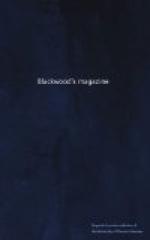“Sleep, Henry, sleep, my best beloved,” he said,[47]
“Soft dreams of bliss shall soothe thy midnight hour;
Connubial transport and collegiate power.
Fly fast, ye months, till Henry shall receive
The joys a bride and benefice can give.
But first to sanction thy prophetic name,
In yon tall pile a doctor’s honours claim;[48]
E’en now methinks the awe-struck crowd behold
Thy powder’d caxon and thy cane of gold.
E’en now—but hark! the chimney sparrows sing,
St Mary’s chimes their early matins ring—
I go—but thou——through many a festive night
Collegiate bards shall chant thy luckless fight—
Though many a jest shall spread the table round,
And many a bowl to B——r——d’s health be crown’d—
O’er juniors still maintain thy dread command,
Still boast, my son, thy cross-compelling hand.[49]
Adieu!”—His shadowy robes the phantom spread,
And o’er the Doctor drowsy influence shed;
Scared at the sound, far off his terrors flew,
And love and hope once more his curtains drew.
[Footnote 18: In the quadrangle of Brazenose College, there is a statue of Cain destroying Abel with a bone, or some such instrument. It is of lead, and white-washed, and no doubt that those who have heard that Cain was struck black, will be surprised to find that in Brazenose he is white as innocence.]
[Footnote 19: All the world has rung with the fame of Roger Bacon, formerly of this college, and of his exploits in astrology, chemistry, and metallurgy, inter alia his brazen head, of which alone the nose remains, a precious relic, and (to use the words of the excellent author of the Oxford Guide) still conspicuous over the portal, where it erects itself as a symbolical illustration of the Salernian adage “Noscitur a naso.”]
[Footnote 20: Two medallions of Alfred and Erigena ornament the outside of the Hall, so as to overlook the field of battle.]
[Footnote 21: The Porter of the college.]
[Footnote 22: The doctor’s servant or scout.]
[Footnote 23: Two wine-merchants residing in Oxford.]
[Footnote 24: To those gentlemen who, for half an hour together, have sometimes had the honour of waiting in the Doctor’s antechamber, “Donec libeat vigilare tyranno,” this passage will need no explanation; and of his acts of graceful dignity and unaffected piety at chapel, perhaps the less that is said the better.]
[Footnote 25: It was a Rosicrucian tenet, that the demon was assimilated to the object of his care; and in this we are confirmed by the authority of the Doctor himself, who treated very largely on the subject of demons in his lecture on Plato’s Phaedon. The powers of his mind were never more successfully displayed than when he illustrated his positions by the scriptural instance of the two Galilean demoniacs, who abode in the tombs night and day. It was reserved for his ingenuity and learning to discover that those unfortunate Bedlamites were not mortals, but departed spirits.]




